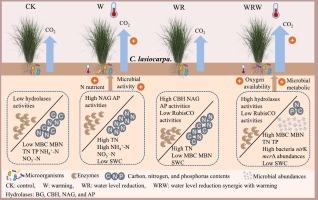升温和水位降低条件下,土壤水解酶和微生物生物量调节湿地CO2排放
IF 5
2区 农林科学
Q1 SOIL SCIENCE
引用次数: 0
摘要
温度和水位变化影响湿地CO2排放,但湿地CO2排放对温度和水协同变化的响应机制尚不明确。以三江平原典型沼泽湿地为研究对象,对其CO2排放量进行监测,并分析其与植物和土壤性质的关系。我们采用了开顶室(OTC)被动升温与自动水位控制平台相结合的方式。设置了对照(CK)、增温(W)、降水位(WR)、增温降水位(WRW)联合处理。结果表明:生长季CO2通量在WRW处理下达到最大值425.26 mg·m−2·h−1;不同水条件下的变暖促进了二氧化碳的排放。水位降低与气候变暖和二氧化碳排放加剧相互作用。增温和水位降低显著提高了土壤水解酶活性、细菌和nirK基因丰度以及微生物生物量碳氮(MBC和MBN)含量。Mantel试验结果表明,土壤β-葡萄糖苷酶(BG)、酸性磷酸酶(AP)活性、MBC、MBN含量、植株TC和土壤温度对累积CO2通量有显著正影响。回归分析表明,空气温度、土壤温度、毛草株高、毛草叶绿素含量是影响三江平原沼泽湿地CO2排放动态的关键因素。这一发现强调了升温和水位下降条件下,水解酶和MBC、MBN含量对沼泽湿地CO2排放的重要影响机制。减缓气候变暖,提高湿地水位抑制湿地水解酶活性,可减少湿地二氧化碳排放,增加湿地碳汇。本文章由计算机程序翻译,如有差异,请以英文原文为准。

Soil hydrolases and microbial biomass regulate wetland CO2 emissions under warming and water level reduction
Changes in temperature and water level affect the wetland CO2 emissions, while the response mechanism of marsh wetland CO2 emissions to temperature and water synergistic change is still rare. We monitored the CO2 emissions and analyzed their relationships with plant and soil properties in a typical marsh wetland of Sanjiang Plain, Northeast China. We utilized the open-top chamber (OTC) passive warming combined with the automatic water level control platform. Four treatments including control (CK), warming (W), water level reduction (WR), combined warming and water level reduction (WRW) were established. The results showed that the CO2 flux in the growing season reached the maximum value of 425.26 mg·m−2·h−1 in the WRW treatment. Warming under different water conditions promoted CO2 emissions. Water level reduction interacted with warming and intensified CO2 emissions. Combined warming and water level reduction significantly enhanced soil hydrolases activities, bacteria and nirK gene abundances, microbial biomass carbon and nitrogen (MBC and MBN) contents. Mantel test results revealed that soil β-glucosidase (BG), acid phosphatase (AP) activities, MBC, MBN contents, plant TC and soil temperature had a significant positive effect on cumulative CO2 flux. The regression analysis demonstrated air and soil temperatures, plant height, chlorophyll content of Carex lasiocarpa were critical factors influencing the dynamic of CO2 emissions in the marsh wetland of the Sanjiang Plain. This finding underscores the essential influence mechanism of hydrolases and MBC, MBN contents on CO2 emissions from marsh wetland under warming and water level reduction conditions. Mitigating climate warming and enhancing wetland water levels to inhibit hydrolytic enzyme activity may reduce wetland CO2 emissions and increase carbon sink.
求助全文
通过发布文献求助,成功后即可免费获取论文全文。
去求助
来源期刊

Applied Soil Ecology
农林科学-土壤科学
CiteScore
9.70
自引率
4.20%
发文量
363
审稿时长
5.3 months
期刊介绍:
Applied Soil Ecology addresses the role of soil organisms and their interactions in relation to: sustainability and productivity, nutrient cycling and other soil processes, the maintenance of soil functions, the impact of human activities on soil ecosystems and bio(techno)logical control of soil-inhabiting pests, diseases and weeds.
 求助内容:
求助内容: 应助结果提醒方式:
应助结果提醒方式:


